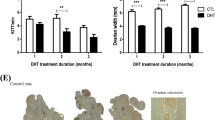Summary
Extensive loss of epithelial cells as a result of enhanced apoptosis was found to play a major role in castration-induced involution of the rat ventral prostate, the ultrastructural features of the phenomenon being essentially the same as those described in other tissues under both physiological and pathological conditions. Affected cells condensed and fragmented to produce membrane-bounded apoptotic bodies with morphologically intact organelles. These were either extruded into acinar lumina, where they underwent a change resembling coagulative necrosis, or were ingested by viable cells, to be rapidly degraded within phagolysosomes. The majority of the bodies were disposed of by macrophage-like cells found scattered along the basal part of the acinar lining, but some were taken up by epithelial cells. Whilst the participation of autophagy in the genesis of diffuse atrophy of remaining viable epithelial cells was confirmed, it should be stressed that the distinction between autophagic vacuoles and apoptotic bodies within heterophagosomes in epithelial cells is sometimes difficult to make.
A low basal rate of ultrastructurally typical apoptosis was observed in the prostates of normal rats, and this was moderately augmented by estradiol administration. Exogenous testosterone prevented both atrophy of epithelial cells and enhancement of apoptosis after orchidectomy. However the dose used did not completely suppress apoptosis. The results indicate that apoptosis can be triggered and inhibited in a differentiated adult tissue by hormones normally present in the blood, and suggest that the control of cell deletion might play just as important a role in the homeostasis of cell populations as does the control of mitosis.
Similar content being viewed by others
References
Altmann, H.-W., Bannash, P.: Die intravitale Karyorrhexis der exokrinen Pankreaszelle im elektronmikroskopischen Bild. Z. Zellforsch.71, 53–68 (1966).
Brandes, D.: The fine structure and histochemistry of prostatic glands in relation to sex hormones. Int. Rev. Cytol.20, 207–276 (1966).
Brandes, D., Groth, D. P.: Functional ultrastructure of the rat prostatic epithelium. In: Biology of the prostate and related tissues. National Cancer Institute monograph 12 (ed.: E. P. Vollmer), p. 47–62. Bethesda: National Cancer Institute 1963.
Deitch, A. D.: Cytophotometry of nucleic acids. In: Introduction to quantitative cyto-chemistry (ed.: G. L. Wied), p. 327–354. New York-London: Academic Press 1966.
Du Praw, E. J.: Cell and molecular biology, p. 525. New York-London: Academic Press 1968.
Farbman, A. I.: Electron microscope study of palate fusion in mouse embryos. Develop. Biol.18, 93–116 (1968).
Fliedner, T. M.: On the origin of tingible bodies in germinal centers. In: Germinal centers in immune responses (eds.: H. Cottier, N. Odartchenko, E. Schindler and C. C. Congdon), p. 218–222. Berlin-Heidelberg-New York: Springer 1967.
Harkin, J. C.: An electron microscopic study of the castration changes in the rat prostate. Endocrinology60, 185–199 (1957).
Harkin, J. C.: Prostatic ultrastructure. In: Biology of the prostate and related tissues. National Cancer Institute monograph 12 (ed.: E. P. Vollmer), p. 85–97. Bethesda: National Cancer Institute 1963.
Helminen, H. J., Ericsson, J. L. E.: Ultrastructural studies on prostatic involution in the rat. Mechanism of autophagy in epithelial cells, with special reference to the rough-surfaced endoplasmic reticulum. J. Ultrastruct. Res.36, 708–724 (1971).
Helminen, H. J., Ericsson, J. L. E.: Ultrastructural studies on prostatic involution in the rat. Evidence for focal irreversible damage to epithelium, and heterophagic digestion in macrophages. J. Ultrastruct. Res.39, 443–455 (1972).
Helminen, H. J., Ericsson, J. L. E., Arborgh, B.: Differing patterns of acid phosphatase and cathepsin D activities in the rat ventral prostate gland during castration-induced prostatic involution. Acta endocr. (Kbh.)69, 747–761 (1972).
Helminen, H. J., Ericsson, J. L. E., Niemi, M.: Lysosomal changes during castration-induced prostatic involution in the rat. Acta path. microbiol. scand.78A, 493–494 (1970).
Kerr, J. F. R.: A histochemical study of hypertrophy and ischaemic injury of rat liver with special reference to changes in lysosomes. J. Path. Bact.90, 419–435 (1965).
Kerr, J. F. R.: An electron-microscope study of liver cell necrosis due to heliotrine. J. Path.97, 557–562 (1969).
Kerr, J. F. R.: An electron microscopic study of liver cell necrosis due to albitocin. Pathology2, 251–259 (1970).
Kerr, J. F. R.: Shrinkage necrosis: a distinct mode of cellular death. J. Path.105, 13–20 (1971).
Kerr, J. F. R.: Some lysosome functions in liver cells reacting to sublethal injury. In: Lysosomes in biology and pathology, vol. 3 (ed.: J. T. Dingle), p. 365–394. Amsterdam: North-Holland (In press, 1973).
Kerr, J. F. R., Searle, J.: The digestion of cellular fragments within phagolysosomes in carcinoma cells. J. Path.108, 55–58 (1972a).
Kerr, J. F. R., Searle, J.: A suggested explanation for the paradoxically slow growth rate of basal-cell carcinomas that contain numerous mitotic figures. J. Path.107, 41–44 (1972b).
Kerr, J. F. R., Wyllie, A. H., Currie, A. R.: Apoptosis: a basic biological phenomenon with wide-ranging implications in tissue kinetics. Brit. J. Cancer26, 239–257 (1972).
Moore, C. R., Price, D., Gallagher, T. F.: Rat-prostate cytology as a testis-hormone indicator and the prevention of castration changes by testis-extract injections. Amer. J. Anat.45, 71–107 (1930).
Müller-Hermelink, H. K., Caesar, R.: Elektronenmikroskopische Untersuchung der Keimzentren in menschlichen Tonsillen. Z. Zellforsch.96, 521–547 (1969).
Swartzendruber, D. C., Congdon, C. C.: Electron microscope observations on tangible body macrophages in mouse spleen. J. Cell Biol.19, 641–646 (1963).
Trump, B. F., Goldblatt, P. J., Stowell, R. E.: Studies on necrosis of mouse liverin vitro. Ultrastructural alterations in the mitochondria of hepatic parenchymal cells. Lab. Invest.14 343–371 (1965).
Wyllie, A. H., Kerr, J. F. R., Macaskill, I. A. M., Currie, A. R.: Adrenocortical cell deletion: the role of ACTH. J. Path. (In press, 1973).
Author information
Authors and Affiliations
About this article
Cite this article
Kerr, J.F.R., Searle, J. Deletion of cells by apoptosis during castration-induced involution of the rat prostate. Virchows Arch. Abt. B Zellpath. 13, 87–102 (1973). https://doi.org/10.1007/BF02889300
Received:
Issue Date:
DOI: https://doi.org/10.1007/BF02889300




